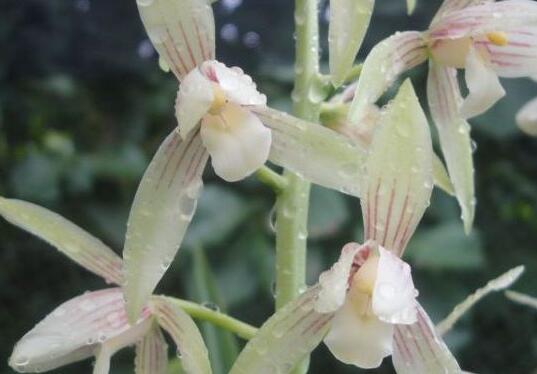How to propagate Cymbidium grandiflora? two propagation methods / ramets of Cymbidium are the most practical.
As an orchid variety cultivated by artificial hybridization, Cymbidium is very effective, simply speaking, it is very ornamental. It is not only pleasing to the eye, but also can purify the air and beautify the home. If such plants are naturally propagated in large numbers, how can Cymbidium reproduce? Here are two propagation methods of Cymbidium. Follow the editor to learn about it.
1. How to propagate Cymbidium grandiflora, split / in vitro

As a novice, you can master the breeding methods of Cymbidium, but if you are an old hand, you should also know the breeding methods of Cymbidium. Only in this way can it be fun to raise. As for how to reproduce Cymbidium, there are two main methods: ramet propagation and in vitro rapid propagation, how to operate, let's move on.
2. Two propagation methods of Cymbidium.
(1) the method of ramet propagation of Cymbidium.
1. Ramet time
If you want to split Cymbidium, you must choose the right time. According to the growth habits of Cymbidium, we can choose the short dormancy period after the flowering of the plant and before the new bud grows; in addition, when ramet, the ramet must be slightly white, soft and dry at the root of the plant, so that the survival rate is high.
2. Ramet selection
Take the sturdy 2-3-year-old Cymbidium, let it take off the pot, and then break it into several pieces with 2-3 false bulbs. After this split is successful, you can get several pots of Cymbidium, but before that, you should apply sulfur powder or toner to the plant wound to avoid infection.
3. Ramet start
After doing the above preparatory work, the method of split propagation of Cymbidium is on the right track: put the seedlings of Cymbidium in a dry place for 1-2 days, and then pot each of them separately, and then propagate successfully. is it very simple? beginners can also try it.
4. Maintenance and management
After the success of the ramet, it does not mean that everything will be all right, and we should also carry out careful maintenance: after the ramet, Cymbidium needs to be placed in the semi-shade, and it is not difficult to water it immediately, and then spray a small amount of water on the leaf surface and basin surface when the basin soil is too dry; the new bud base can not be watered normally until the new root grows.
(3) Rapid propagation of Cymbidium in vitro.
In addition to ramet, we can also use the method of in vitro propagation of Cymbidium. The specific operation is as follows: from January to early March, the new buds of Cymbidium are taken, sterilized, inoculated on the solid medium, and the test-tube plantlets are obtained. then cut off the roots of the test-tube plantlets, take the small pieces at the base, inoculate them on the solid medium for about a month, induce the protocorm, remove the protocorm, and continue to produce new protocorms in the original part.
The protocorms were cultured alternately on liquid and solid media and proliferated rapidly to form protocorms. Then cut the protocorm and transfer it to the solid medium to differentiate the plant, then cut it from the base and transfer it to the solid medium for about a month, and then form a complete plant and transfer it to the greenhouse or greenhouse. This method has the advantages of low cost and low probability of variation, so senior flower friends can try it.
Generally speaking, Cymbidium can survive regardless of whether it is ramet propagation or in vitro propagation, but for ordinary flower friends, it is OK to master ramet. If you have a big pot of cymbidium around you, and you happen to want to raise one more pot, you might as well try it yourself. With regard to the breeding methods of Cymbidium, the editor has introduced this, hoping to give you some help.
How to propagate Cymbidium grandiflora and the method of multiplication of Cymbidium grandiflora
Cymbidium has elegant columnar shape, colorful flowers and overflowing fragrance, so Cymbidium is very popular among people, and there are not a few breeders, so how can Cymbidium propagate in different plants? I believe that the friends who cultivate Cymbidium want to know the problems. Let's introduce the method of plant propagation of Cymbidium.
How to propagate Cymbidium grandiflora and the method of multiplication of Cymbidium grandiflora
Cymbidium can generally be propagated by ramet method, and it is a suitable time for ramet when new buds begin to sprout in spring. The new plant after ramet should have more than 3 pseudobulbs. After cutting and waiting for the wound to dry, the normal plant can split once every 3 years. The tool should be disinfected when ramet, so as not to cause virus infection. The potted Cymbidium should be placed in a warm and humid environment until the new buds protrude from the soil and can be managed according to the normal method.
Take the sturdy plant out of the basin, cut it off from the junction of the pseudocorm with a sharp knife and cut it into several clumps, each with 2 or 3 pseudocorms (one of which must be newly formed in the previous year). Smear the incision with sulfur powder or charcoal powder in time, put the new plant in a dry place and dry for 1 or 2 days, then put it into the basin separately. The suitable time for ramet is after the flower fade to before the new bud grows.
If possible, aseptic sowing, fertilized embryo culture, tissue culture and other methods can be used for mass propagation. Note that the false corms must all be exposed to the surface of the culture soil. Put it in the half-shade and half-sun place after planting, because the cultivated soil is wet, so avoid watering within 1 week after planting, only spray water on the leaf surface (usually spray 4-6 times a day), and gradually turn to normal maintenance after 1 week.
The Culture method of Cymbidium the Propagation method of Cymbidium
Cymbidium (Latin name: Cymbidium), also known as Cymbidium, Cicada orchid, Cymbidium, and so on, today we are going to talk about the culture methods and propagation methods of Cymbidium.
Culture methods of Cymbidium:
1. Soil: Cymbidium requires loose, ventilated and well-drained cultivation substrate, which can be planted with rotten leaf soil or mixed cultivation with moss, charcoal, fern root, charcoal, bark, broken bricks and so on. It is not suitable to use ordinary culture soil and culture soil for planting Chinese orchids. Poorly ventilated and drained soil can lead to root rot.
2. Watering: Cymbidium likes higher air humidity. In spring, summer and autumn, while giving sufficient water to the roots, the leaves should be sprayed frequently. However, during the short dormancy period after flowering in early spring, Cymbidium must be watered less and more watering only when the new buds grow larger and new roots.
3. Sunshine: the growth of Cymbidium needs sufficient scattered light, shading net should be used to shade about 50% in summer and autumn, and open shading net to accept direct light on cloudy days or when the sun is soft in winter and spring. However, during the flowering period, the orchid plant should be placed in a place with weak light so that it can blossom brightly.
4. Temperature: warm in winter and cool in summer, and the suitable temperature for growth is 10 ℃ to 25 ℃. The suitable temperature at night is about 10 ℃, especially when the temperature is above 5 ℃ during flowering, and the flowering period can be prolonged by more than 3 months when the temperature is below 15 ℃.
5. Fertilization: during the growth period, thin fertilizer should be applied frequently, and thin chemical fertilizer or compound fertilizer can be applied. If more bone meal and mature bean cake fertilizer are applied, the flowers will be larger and more. Liquid fertilizer should be diluted at 1 ∶ 1000 and applied once every 10 days. Sufficient fertilizer should be applied before flowering, and no fertilizer should be applied during flowering and midsummer.
6. Insect pests: Cymbidium is vulnerable to diseases and insect pests if the cultivation environment is bad. Common diseases include Fusarium disease, black rot, soft rot, anthracnose, gray mold, white silk disease, etc., so it is necessary to spray fungicide every half a month to prevent the occurrence of diseases, and special attention should be paid to the cleaning of environmental sanitation, water sources, plant materials and utensils.
7. Pruning: the pseudobulm of Cymbidium generally contains more than 4 leaf buds. In order not to disperse nutrition, the new buds and their growing points must be removed thoroughly. This operation should start from the end of the flowering period, pick buds once a month and stop before the new flowering period, so as to concentrate nutrition, strengthen the mother corm and make the flowers bloom bigger and more.
Propagation methods of Cymbidium:
The propagation of Cymbidium is usually propagated by ramets, which is not only simple, but also has a high success rate. The ramet of Cymbidium is best carried out during the dormancy period after flowering, when the flower does not need too much nutrients and the new bud has not yet grown, so it is more suitable for ramet. The cultivation methods and precautions of Cymbidium need to take several steps before the split, first of all, it should be properly dried for a period of time to make its roots white and soft. Then the orchid seedlings with 2-3 false phosphorus stems are cut and the cutting wound can be smeared with sulfur powder or carbon powder to prevent its infection. After intercepting, let it dry for 1-2 days and then pot, it can grow into a new plant. Generally speaking, robust plants can be divided only once every 2-3 years, not too frequently. New plants can't be watered immediately, but they can spray water on the leaves to prevent them from drying up and falling off.
- Prev

How to breed duck foot wood, duck foot wood propagation method/sowing cuttings can be
In evergreen shrubs, duck foot wood is one of the most popular varieties, in addition to it is very easy to feed, duck foot wood propagation is also very easy, such as sowing, cutting, layering and so on are very practical. It's simple, but it needs to be done right.
- Next

How to breed ink orchids, ink orchids breeding methods/ramets high survival rate
Ink orchid is a common flower plant in the world, with a high ornamental, there are many people who cultivate it in our country, with more people cultivating it, people are more concerned about its reproduction problems, so how does ink orchid reproduce? What are the breeding methods of ink orchids
Related
- Fuxing push coffee new agricultural production and marketing class: lack of small-scale processing plants
- Jujube rice field leisure farm deep ploughing Yilan for five years to create a space for organic food and play
- Nongyu Farm-A trial of organic papaya for brave women with advanced technology
- Four points for attention in the prevention and control of diseases and insect pests of edible fungi
- How to add nutrient solution to Edible Fungi
- Is there any good way to control edible fungus mites?
- Open Inoculation Technology of Edible Fungi
- Is there any clever way to use fertilizer for edible fungus in winter?
- What agents are used to kill the pathogens of edible fungi in the mushroom shed?
- Rapid drying of Edible Fungi

